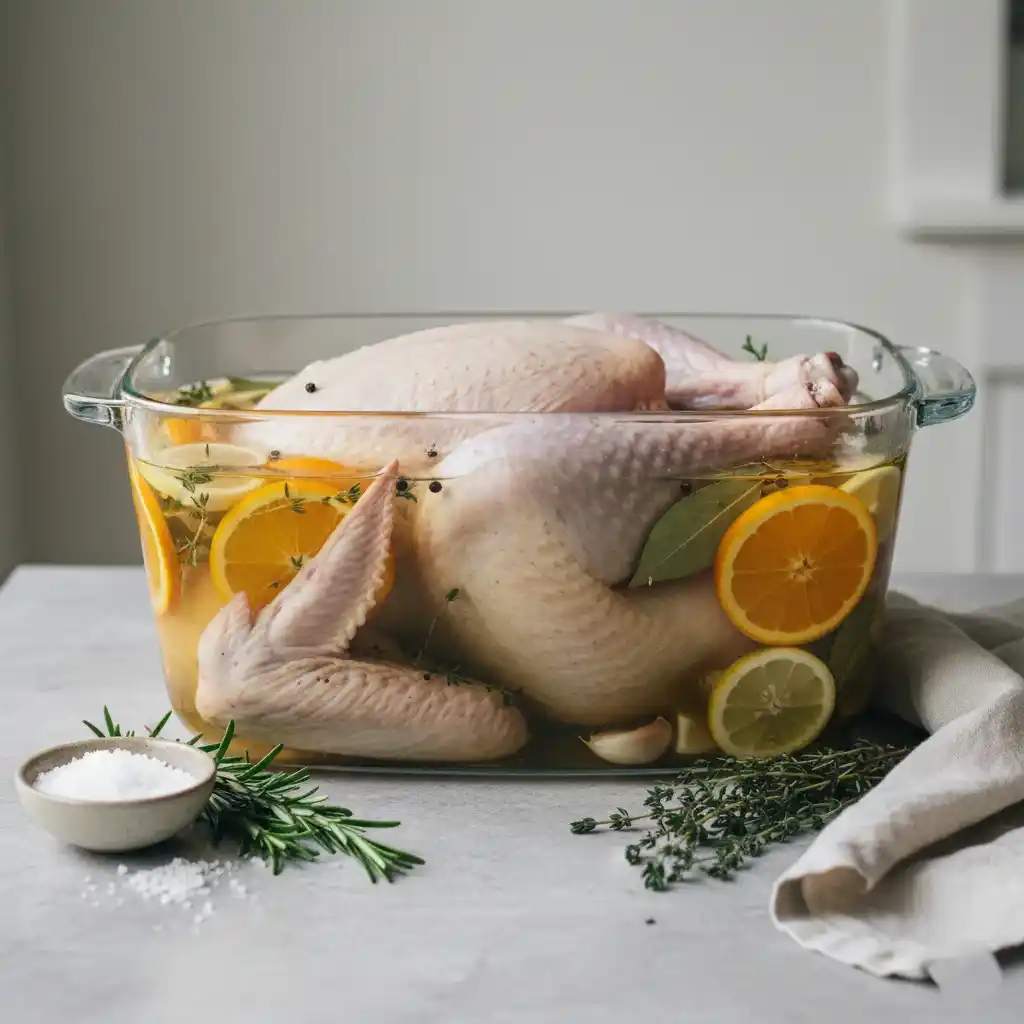There’s a quiet moment before the holiday rush begins — the kitchen still, the bird waiting, and the brine ready to work its magic.
I’ve learned over the years that a good brine doesn’t just season a turkey; it changes the way the meat feels when you carve it.
It’s the secret behind that deep, juicy tenderness that makes everyone pause after the first bite.
Every year, I watch the salt melt into the water, the herbs open up, and the citrus release its scent. It’s the calm before the feast — the part that no one sees but always tastes.
This is the step that separates a good turkey from one that stops conversation. Take your time here.
Let the ingredients do their quiet work. When the oven timer finally rings, you’ll know it was worth every hour.
Turkey Brine Recipe
Ingredients:
- 1 whole turkey (12–14 pounds), thawed
- 1 ½ cups kosher salt
- 1 cup brown sugar
- 2 oranges, sliced
- 1 lemon, sliced
- 4 bay leaves
- 10–12 garlic cloves, smashed
- 2 tablespoons whole black peppercorns
- 1 tablespoon whole allspice (optional)
- 8–10 sprigs of fresh thyme
- 4–5 sprigs of fresh rosemary
- 1 gallon water (for boiling the brine mixture)
- 1 gallon cold water (for cooling the brine)
- Ice cubes (optional, for chilling the brine quickly)
Instructions
- In a large pot, combine 1 gallon of water, salt, brown sugar, bay leaves, garlic, peppercorns, and allspice. Bring it to a gentle boil over medium heat, stirring occasionally until the salt and sugar dissolve completely.
- Remove the pot from heat and add the sliced oranges, lemon, rosemary, and thyme. Let the mixture steep for about 30 minutes to release all the aromatic oils from the herbs and citrus.
- Pour in 1 gallon of cold water to help cool down the brine. If it’s still warm, add a few handfuls of ice cubes to speed up the cooling process. The brine must be completely cold before adding the turkey.
- Place the turkey in a large non-metallic container or a heavy-duty brining bag. Slowly pour the cooled brine mixture over the turkey, ensuring it is fully submerged.
- Cover the container and refrigerate for 12 to 18 hours. For a smaller turkey, 10 to 12 hours is enough; for a larger one, aim for 18 to 24 hours.
- Once the brining time is complete, remove the turkey from the liquid. Discard the brine—it’s done its job.
- Rinse the turkey thoroughly under cold running water to remove excess salt from the surface, then pat dry with paper towels.
- Transfer the turkey to a large tray and refrigerate uncovered for 1 to 2 hours before roasting. This step helps the skin dry out slightly, which leads to crispier, golden skin after cooking.
- Proceed with your favorite turkey roasting recipe as usual.

What Is Turkey Brining And Why Does It Matter?
Brining is the process of soaking a turkey in salted water mixed with herbs, spices, and other flavor boosters. It’s an old kitchen trick that makes a huge difference in how the turkey tastes and feels when cooked.
- Locks In Moisture: Brining helps the meat absorb and hold onto water, so it stays juicy even after long roasting hours.
- Adds Deep Flavor: The salt opens the turkey’s fibers, allowing the herbs, garlic, and citrus to go beyond the surface.
- Improves Texture: It gives a soft, tender bite that doesn’t dry out easily.
- Ensures Even Cooking: A brined turkey cooks more evenly, preventing dry breast meat and undercooked legs.
How Long Should You Brine A Turkey?
The time your turkey spends in brine decides how well the flavors settle in.
- Whole Turkey: Brine for 12 to 24 hours in the refrigerator.
- Turkey Parts (like breast or legs): Brine for 6 to 12 hours.
- Tip: If brining longer than 24 hours, reduce the salt slightly to prevent an overly salty taste.
- Rest Before Cooking: After removing the turkey from the brine, pat it dry and rest it uncovered in the fridge for an hour. This helps the skin crisp beautifully in the oven.
What Ingredients Give The Best Flavor To Turkey Brine?
A good brine balances salt, acid, and aromatics. Each ingredient has a role that changes the final flavor.
- Salt: The heart of any brine. It breaks down protein fibers so the turkey absorbs moisture.
- Sugar Or Honey: Adds a gentle sweetness and helps in browning the skin during roasting.
- Citrus Fruits: Oranges and lemons add brightness that balances the richness of the meat.
- Herbs: Rosemary, thyme, and bay leaves add an earthy, fragrant base.
- Garlic And Peppercorns: Build warmth and spice without overpowering the main flavor.
- Water Or Broth: Acts as the liquid carrier for all the flavors to mix and penetrate evenly.
Can You Brine A Frozen Turkey?
Yes, but it takes careful timing. A frozen turkey can brine while thawing, but the cold must stay consistent.
- Start With A Thawed Or Semi-Thawed Bird: Brine works best when the turkey is mostly thawed, allowing salt to reach all parts evenly.
- Keep It Refrigerated: Never let the turkey sit in brine at room temperature; it must stay below 40°F (4°C) for food safety.
- Extend The Time: Since frozen meat absorbs slowly, allow up to 48 hours if starting from a partially frozen state.
Should You Rinse The Turkey After Brining?
This is a common question that causes confusion. The answer depends on the brine and how you plan to season next.
- Skip The Rinse: Most of the time, it’s better not to rinse. Pat dry with paper towels to remove excess moisture instead.
- Rinsing Risks: Washing the turkey can splash bacteria around your sink. Drying is safer and more effective.
- Optional Step: If your brine was very salty, a light rinse followed by drying can help balance the taste.
Can You Make Turkey Brine In Advance?
Preparing the brine ahead saves time and enhances flavor.
- Make It 2 Days Ahead: Prepare the brine liquid and refrigerate it once cooled completely.
- Cool Before Adding Turkey: Never pour warm or hot brine over raw turkey. Always let it chill first.
- Store Properly: Keep the brine in an airtight container or large jug until you’re ready to use it.
What Are The Common Mistakes To Avoid When Brining A Turkey?
Brining seems simple, but small errors can affect the outcome.
- Too Much Salt: Always measure salt correctly. Too much can make the turkey overly salty and tough.
- Not Enough Time: Short brining leads to uneven seasoning and dry meat.
- Warm Storage: Leaving the turkey outside the fridge is unsafe and can cause bacterial growth.
- Skipping The Drying Step: Wet skin prevents crispiness; pat dry before roasting.
- Using Old Herbs: Fresh herbs always give stronger, cleaner aromas than dried ones.
Can You Reuse Turkey Brine?
No, the brine should never be reused.
- Safety Reason: Once raw turkey has been in the brine, the liquid is contaminated and unsafe to keep.
- Flavor Reason: The first use extracts salt and flavor; the leftover liquid becomes unbalanced and weak.
- Better Option: Make a fresh batch if you plan to brine again.
What Difference Does Dry Brining Make Compared To Wet Brining?
Both methods improve flavor, but the texture and process differ.
- Wet Brine: Soaks the turkey in liquid, giving deep moisture and juiciness.
- Dry Brine: Rubs salt and spices directly on the turkey skin and meat, saving fridge space and creating a crispier crust.
- Choice Tip: Wet brine is great for large birds that need moisture, while dry brine suits smaller turkeys or those seeking intense skin crispiness.

How To Store A Brined Turkey Safely?
Storage is just as important as the brining itself to keep the turkey safe and flavorful.
- Use A Large Food-Grade Container: Always choose a non-reactive bowl, bucket, or bag. Avoid aluminum because salt can react with it.
- Keep The Temperature Cold: Store the turkey in a refrigerator at below 40°F (4°C). If your fridge is small, use an insulated cooler with ice packs.
- Change Ice Regularly: When using a cooler, check and replace ice every few hours to maintain a steady cold temperature.
- After Brining: Remove the turkey, discard the used brine (never reuse it), and pat the meat dry before cooking.
- Leftovers: Once cooked, store leftover turkey in airtight containers in the fridge for up to 4 days or freeze for 2 months.
You May Also Like To Check Out These Recipes
- Green Bean Casserole
- Roast Turkey
- Turkey Pinwheels
- Turkey Cheese Ball
- Turkey Gravy
- Maple Leaf Cookies
- Sourdough Focaccia Bread
- Turkey Sliders On Hawaiian Rolls
- Ambrosia Salad With Fruit Cocktail
- Crustless Pumpkin Pie
- Pumpkin Pie Cookies
- Pumpkin Chocolate Chip Cookies
- Creamy Pumpkin Soup With Roasted Seeds
- Soft & Fluffy Pumpkin Chocolate Chip Muffins
- Sweet Potato Casserole With Marshmallows
- Homemade Pumpkin Pie
- Decorated Pumpkin Shaped Cookies
- Mexican Street Corn White Chicken Chili
- Peanut Butter Fudge
- Pumpkin Bread Truffles
- Pumpkin Fudge
- Pumpkin Cake Roll With Cream Cheese Filling
- Sweet Potato Cake
- Pumpkin Cupcakes With Caramel Cream Cheese Frosting
- Beef Stuffed Acorn Squash
- Air Fryer Pumpkin Seeds
- Pumpkin Empanadas
- Pumpkin Cheese Ball
- Apple Crisp With Oats And Melted Butter
- Pumpkin Fluff Dip
- Pumpkin Bread
- Vegan Creamy Pumpkin Gnocchi
- Roasted Pumpkin Seeds
- Pumpkin Snickerdoodle Cookies
- Fall Fruit Salad
- Pumpkin French Toast Sticks
- Pumpkin Cheesecake Bars
- Baked Pumpkin Oatmeal
- 5-Minute Pumpkin Spice Latte
- Pumpkin Bars With Cream Cheese Frosting
- Pumpkin Cream Cold Foam

